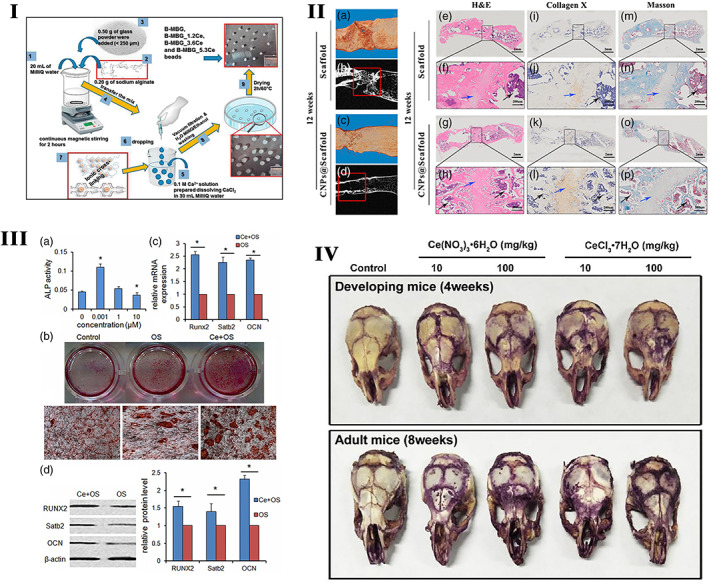FIGURE 1.

I. Schematic representation of the preparation of the alginate/glass beads with ceria to prevent oxidative stress in MC3T3‐E1. Source: Reprinted with permission from ref. 234. Copyright 2019, Elsevier. II. The effect of cerium‐doped nanoparticles on osteogenesis (a–d). Representative micro‐CT (b, d) and 3D reconstruction (a, c) images of femurs 12 weeks after ceria‐based scaffold implantation. The red solid line frame outlines the bone defect area. (e–h) H&E staining at 12 weeks post‐surgery. (i–l) Collagen X IHC staining at 12 weeks post‐surgery. (m–p) Masson's trichrome staining at 12 weeks post‐surgery. The solid black box represents the enlarged defect area. Blue arrowheads indicate hypertrophic chondrocytes, and black arrowheads represent new trabecular bone formed by endochondral ossification (n = 3/group). Source: Reprinted with permission from ref. 125. Copyright 2019, John Wiley & Sons, Inc. III Ce promotes bone marrow mesenchymal stem cells (BMSCs) osteogenic differentiation ex vivo. (a) BMSCs were treated with various concentrations of Ce (0, 0.001, 1, 10 μM) for 7 days and assessed by measuring the alkaline phosphatase (ALP) activity. (b) BMSCs were treated with standard, OS, and OS + Ce medium for 21 days and assessed by alizarin red S staining. (c) Quantitative real time PCR analysis indicated that the mRNA expressions of Runx2, Satb2, and OCN were significantly up‐regulated in the BMSCs treated with Ce (0.001 μM) for 7 days compared to the control group. (d) Western bolt analysis showed the expressions of RUNX2, Satb2, and OCN proteins were up‐regulated after treatment with Ce (0.001 μM) for 7 days. Data are presented as mean ± SD from a representative of three separate experiments. *p < 0.05. Source: Reprinted with permission from ref. 205. IJCEP Copyright 2014. (IV) The TRAP staining of mice skull treated with cerium for 9 days. Source: Reprinted with permission from ref. 79. Copyright 2019, Elsevier. TRAP, tartare resistant acid phosphatase
